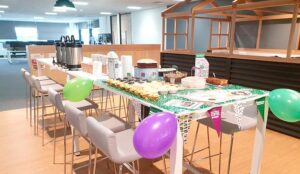Here are 14 interesting ideas that we picked up on a site visit to the new Which? contact centre in Cardiff.
1. Move Away From Team Leaders and Towards Team Coaches
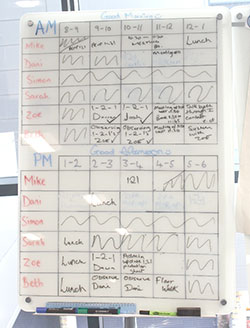
The coaches set out their daily plans on whiteboards
Contact centres are mostly very traditional in their structures, but Which? wants to challenge this and has replaced team leaders with team coaches to better support their advisors.
To facilitate this change, Which? recruited an additional operations manager, who would handle admin duties, meaning that coaches would have more time to spend with advisors.
Not only is it made clear to coaches that spending time with advisors and helping them develop their performance is their sole objective, coaches also get to decide what their day looks like.
In a quick morning briefing, the coaches will get together with the manager and discuss who they want to have one-to-ones with, what incentives they plan to run and so on – creating a daily plan.
Coaches can also share best practices with one another, before the floor is theirs to implement their plan.
There is roughly one coach for every eight advisors, but Which? soon plans to have contact centre coaches instead of team coaches, to take every possible silo from the contact centre and create a unique team atmosphere.
Since Which? introduced coaches to replace leaders across both of its existing contact centres, attrition has fallen from 50% to 10% and advisor engagement is up by a hugely impressive 80%.
2. Equip Coaches With Tablets and Laptops
With the transition from team leaders to team coaches, Which? equipped each of its coaches with laptops and tablets to help them work on the move.
If they have one-to-ones with advisors, they can come to them and work alongside them, instead of having to go into a separate room. This takes away any perceived hierarchy, and Which? makes it clear to advisors that coaches are there to support them, and the manager is there to support the coaches – inverting the conventional “pyramid of hierarchy”.
| Which? Fact File | |
|---|---|
| Call Volumes – avg. per year | Inbound contacts: 600,000 |
| Advisors | 70 seats 50 FTE |
| Technology | |
| ACD | Cisco |
| Headsets | Verso |
| Wallboards | Cisco |
| Workforce Management (WFM) | Verint |
| Advisor Desktop | Cisco |
| Call Recording | Cisco |
| Call Scoring | Internal |
| Speech Analytics | Zoom |
In fact, there were no offices where coaches or managers could hide themselves away from the team: they worked in “hubs” that were identical to those that the advisors worked in. This makes it clear to the team that everyone is approachable and helps to perpetuate a team ethos.
If a manager needs to handle a confidential call, they can just move into a training room – but the whole contact centre was specifically designed with the purpose of bringing everyone together.
In fact, when recruiting coaches, Which? looked specifically for candidates who could be a social link in the contact centre. It was not about promoting someone because they made a good advisor – it was about finding people who could engage and motivate the whole team.
3. Double Average Handling Time When Resource Planning
Like many contact centres, Which? does not target advisors on Average Handling Time (AHT). If the team were to feel a time pressure, it could cause them to rush through calls, which wouldn’t be in the best interest of the customer.
However, Which? has gone one step further. When calculating how many advisors are needed to staff the contact centre, they input an AHT that is much higher than their actual AHT, to give advisors much longer on the phones and ensure they don’t feel any time-based pressure.
In fact, the actual AHT recorded at the Which? contact centre is slightly over 300 seconds, but they plan for an AHT of 600 seconds, while actively encouraging advisors to “go the extra mile” for the customer.
In the view of Which?, the contact centre definition of effectiveness is very different from the factory definition. Instead of time-based targets, such as AHT and occupancy – which are often outside of the contact centre’s control – effectiveness is best assessed through consistently high Customer Satisfaction (CSat) and Quality scores.
4. Specialise Certain Advisors in Handling Calls From Vulnerable Customers
Once a customer has been identified as vulnerable, future calls are routed through to a specialist advisor, who has been trained to handle these difficult conversations.
These advisors are well prepared to interact with customers who have mental health problems, learning difficulties, Parkinson’s etc., while all advisors are taught how to identify signs of vulnerability while remaining respectful.
Which? have also developed processes and procedures to support staff dealing with vulnerable consumers. However, the first lesson is to ensure that the vulnerable customer doesn’t feel as though they have been singled out. This can cause the customer to feel embarrassed, irritated or even offended.
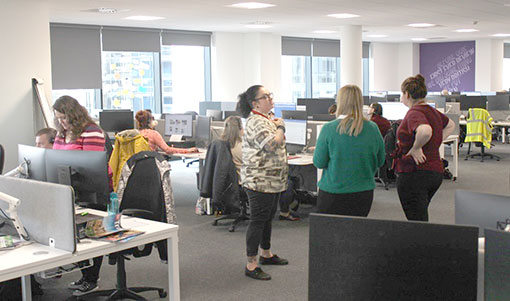
Take a look inside the Which? contact centre!
5. Recruit Advisors From the Shaw Trust
The Shaw Trust is a charity that specialises in helping disabled and disadvantaged people into employment. Which? have a great relationship with the charity and work with them to find potential advisors.
Which? believe that, due to their diverse customer base, they should have a diverse contact centre team and, as they were originally set up as a charity themselves, feel that it’s important to give back to the community.
One 25-year-old advisor was recruited through the Shaw Trust and has a visual impairment. Despite being of such a young age, he didn’t think he would ever find meaningful work.
However, the Which? team were very impressed with his soft skills and gave him a job, only having to install a specialised computer screen for him, which didn’t cost much more than £200.
With this small investment, the contact centre has helped to help give the advisor an independent work-life and he’s given them good skills and a great attitude – creating a real bond between the advisor and the company.
In addition to the Shaw Trust, Which? discuss ideas for how they can give back to the community with the local government. The team seemed to really appreciate the work the company did for the area in which they live.
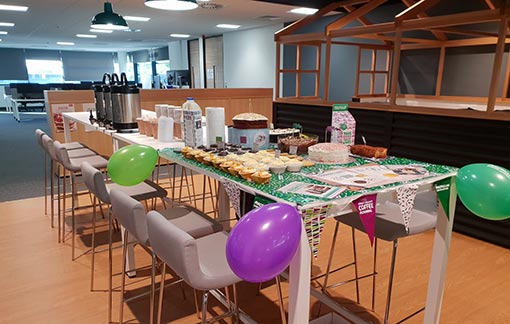
Here’s a picture of a contact centre coffee morning that helped to raise money for charity.
6. Coach Resilience as a Soft Skill
As part of the contact centre’s induction training, soft skills such as reflective listening, empathy and problem-solving are key areas that Which? focuses on. However, resilience is also included in this training.
By covering resilience in induction training, Which? is preparing advisors for the reality of the contact centre. This is one reason why the company believes that its short-term attrition rates are so low.
Due to the nature of Which?’s research and reviews, as they often rank products against one another, advisors need to be prepared to handle calls from passionate customers with strong opinions.
Recognising this, Which? values the importance of coaching advisors to handle emotionally challenging calls and taking care of the team, on and off the phone.
7. Offer Mindfulness Sessions
Recognising that the contact centre can sometimes be an emotionally challenging place to work, Which? offers monthly mindfulness sessions.
In these sessions, professional speakers come into the contact centre to run seminars with the team on a number of different topics, including self-reflection, sleeping better and de-stressing. These sessions show that Which? cares not only about their advisors’ work lives, but about their home lives too.
As well as mindfulness sessions, Which? runs yoga classes and brings in a professional masseuse. What better way is there to de-stress?
Outside of work, advisors receive discounts at certain shops, restaurants and cinemas, which extend to also include holidays and days out.
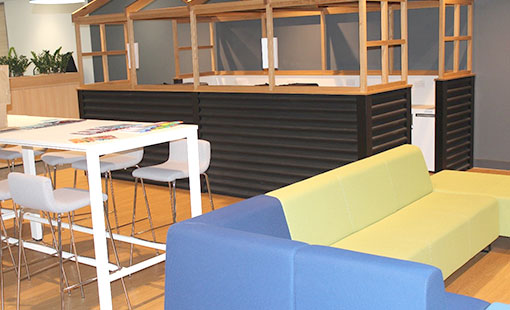
The break room shed is a homage to where Which? was founded.
8. Use Speech Analytics to Find a Set of “Musts”
To get the most out of their speech analytics system, Which? has recruited two data analysts to spot trends that can be of benefit to all areas of the organisation, including the contact centre.
While the speech analytics system is predominantly used by the contact centre to automate quality scorecards, which helps to inform coaches of the areas that each advisor may need extra support with, the contact centre likes to use the technology for trend spotting.
For example, the contact centre tasked the two data analysts with analysing 1,000 contacts that had resulted in a really high CSat scores and asked them to find commonalities in them. In other words, they wanted to find the ingredients to a really great call, through the eyes of their customers.
In doing so, the analysts came up with five “musts”, which advisors are asked to be mindful of when handling calls:
i. Use the Which? warm welcome
ii. Use the Which? brand tone
iii. Reduce call escalations
iv. Reduce jargon and technical language – be easy to understand
v. Ask yourself: have we answered the customer’s query?
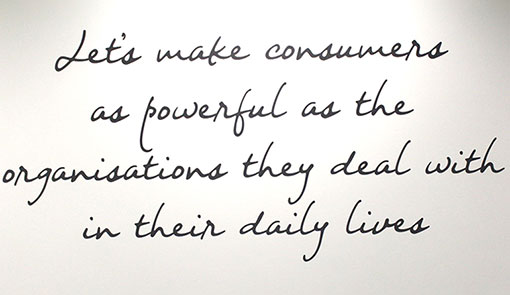
Take a look at this motivational message inscribed on a wall in the Which? contact centre.
9. Equip Advisors With Dual Screens
A New York Times report found that dual screens helped to improve the average office worker’s productivity by 20-30%. But this wasn’t the only reason Which? decided to install dual monitors.
Much of the focus at Which? has been on making the advisor experience as straightforward as possible and that will, in turn, help to streamline the customer journey.
By making things easier for advisors, through focusing on repairing broken processes and speeding up slow systems, Which? is actively looking to remove sources of advisor demotivation.
10. Split Customer Satisfaction Between Contact Types
CSat is often measured as a “pat on the back metric”, but Which? likes to ensure that it gains some benefits from the measure.
As well as using speech analytics to analyse high CSat contacts, the contact centre also splits CSat between contact types and call reasons.
By doing this, the company can identify the call reasons that cause the least satisfaction to customers and then assess the customer experience to look for ways to build satisfaction for future contacts who follow this journey.
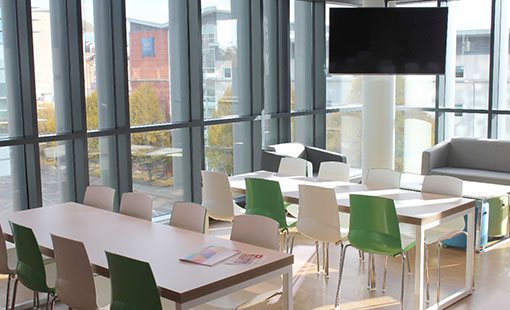
The break room has a great view of the surrounding Cardiff area.
11. Refrain From Asking “Empty Questions”
Effective questioning is something that Which? prides itself on and the first step is reflective listening. This includes listening to the customer query and then summarising it back to them, to ensure that everything has been fully understood.
But sometimes advisors have to probe for more information. Which? doesn’t want advisors jumping into solutions which might not be right for the customer.
So Which? suggests that advisors ask questions where they can find out some more information about their customer. This is more valuable than asking “empty questions”, such as “how are you?” The more the advisor finds out about the customer, the more likely they are to find the right solution for them.
12. Share Monthly Presentations With Marketing
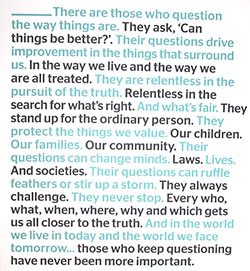
One of the greatest challenges that many contact centres face is when the marketing department sends out a mailing to a large proportion of the customer base, without their knowledge. All of a sudden, the contact centre struggles to cope with a peak in demand.
Which? has managed to get around this problem, as their marketing team visits the contact centre each month to give a presentation sharing its plans for the next month. This helps Resource Planning to accurately create forecasts, while the teams can align their communications, to ensure that they do not overwhelm customers.
In addition, the marketing team talks to the contact centre team during their visit, to find out what customers are talking about. This helps in the creation of new marketing material.
The editor of Which? Magazine does the same, so the company can be sure that they are writing about the topics that their customers want and are talking about.
13. Introduce a “Beat the Coach” Game
Which? has introduced a number of fun initiatives into the contact centre, to help build an atmosphere where their people want to come into work.
Pizza Fridays, a pyjama day and even a contact centre sports day have all been tried out on the floor, but one game that really caught the eye was called “Beat the Coach”.
When an advisor scores a certain number of perfect CSat scores, they can challenge a coach to a game of their choosing. The latest game was a contest to see who could eat a doughnut without licking their lips.
Every game is devised by the advisors themselves, instead of coaches or even managers “mandating” the fun. This ensures that the whole team is invested in each initiative.
The “Beat the Coach” game also helps Which? to demonstrate to advisors that their focus is on CSat as opposed to selling subscriptions.
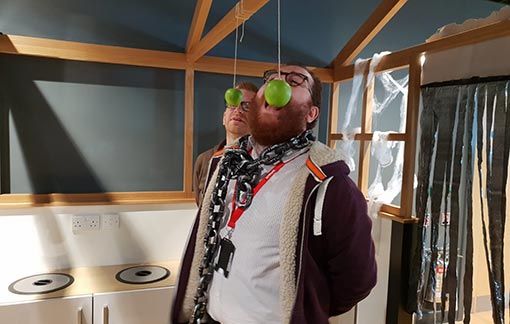
Trying to eat an apple without hands is another game that the team chose to play.
14. Follow These Tips When Writing a Customer Service Letter
As Which? has great diversity in their customer base, they cater to a large number of communication preferences – they even still have a working fax machine!
But one slightly more common channel choice is the letter, and Which? gave us these three tips for writing the ideal customer service letter.
i. Structure the letter in order of value to the customer – Get to the point quickly, while using headings and bullet points to signpost what’s important to the customer.
ii. No jargon – Use simple words instead of complex phrases and acronyms, while trying to break down complex sentences. Think about sticking to one idea per sentence.
iii. End on a high note – Close the letter so that the customer feels reassured. Leave the customer feeling positive with clear next steps and a timescale – if necessary.
Thank you to Which? for facilitating our visit to its Cardiff contact centre.
But what about you? Do you fancy showing off your contact centre?
If so, you can contact: newsdesk@callcentrehelper.com and maybe we will see you soon!
Author: Robyn Coppell
Published On: 12th Dec 2018 - Last modified: 21st Jan 2025
Read more about - Call Centre Management, Coaching, Recruitment, Setup, Site Visits, Speech Analytics





